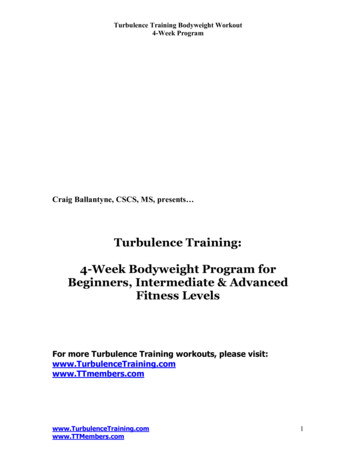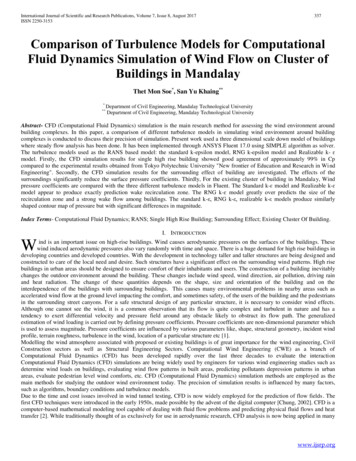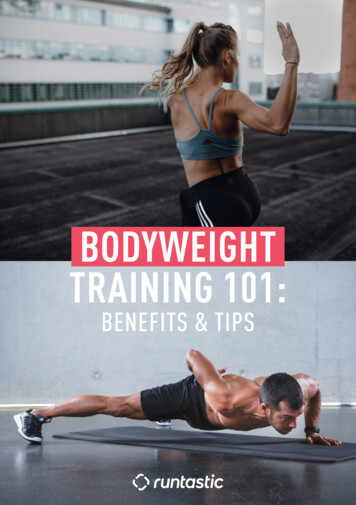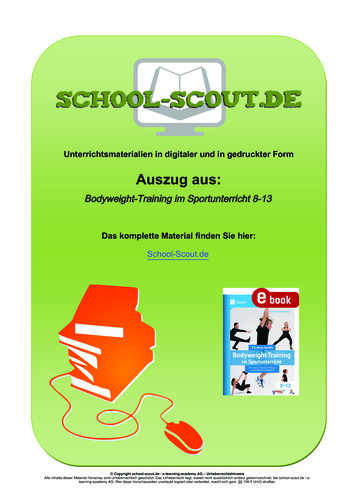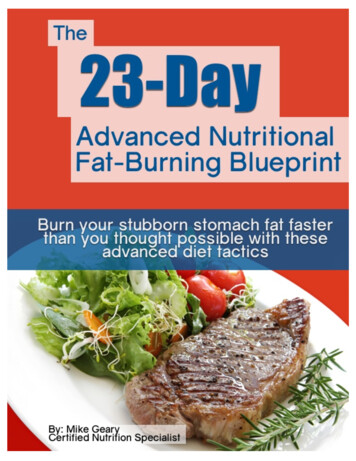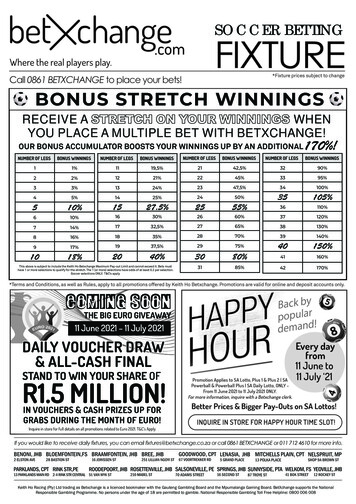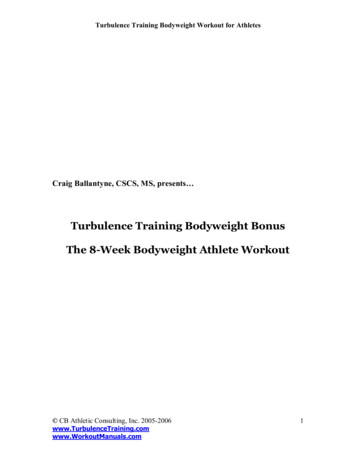
Transcription
Turbulence Training Bodyweight Workout for AthletesCraig Ballantyne, CSCS, MS, presents Turbulence Training Bodyweight BonusThe 8-Week Bodyweight Athlete Workout CB Athletic Consulting, Inc. als.com1
Turbulence Training Bodyweight Workout for AthletesSection PageWhat Athletes Need . 4TT Guidelines . 6TT Workouts . 7TT Exercise Descriptions . 12This information in the Turbulence Training report is for education purposes only. It isnot medical advice and is not intended to replace the advice or attention of health-careprofessionals. Consult your physician before beginning or making changes in your diet orexercise program, for diagnosis and treatment of illness and injuries, and for adviceregarding medications.Craig Ballantyne, CSCS, M.Sc.,Author, Turbulence Training CB Athletic Consulting, Inc. als.com2
Turbulence Training Bodyweight Workout for AthletesDisclaimer:You must get your physician’s approval before beginning this exercise program.These recommendations are not medical guidelines but are for educational purposes only.You must consult your physician prior to starting this program or if you have any medicalcondition or injury that contraindicates physical activity. This program is designed forhealthy individuals 18 years and older only.The information in this report is meant to supplement, not replace, proper exercisetraining. All forms of exercise pose some inherent risks. The editors and publishersadvise readers to take full responsibility for their safety and know their limits. Beforepracticing the exercises in this book, be sure that your equipment is well-maintained, anddo not take risks beyond your level of experience, aptitude, training and fitness. Theexercises and dietary programs in this book are not intended as a substitute for anyexercise routine or treatment or dietary regimen that may have been prescribed by yourphysician.See your physician before starting any exercise or nutrition program. If you are takingany medications, you must talk to your physician before starting any exercise program,including Turbulence Training. If you experience any lightheadedness, dizziness, orshortness of breath while exercising, stop the movement and consult a physician.Don’t perform any exercise unless you have been shown the proper technique by acertified personal trainer or certified strength and conditioning specialist. Always ask forinstruction and assistance when lifting. Don’t perform any exercise without properinstruction. Always do a warm-up prior to strength training and interval training.You must have a complete physical examination if you are sedentary, if you have highcholesterol, high blood pressure, or diabetes, if you are overweight, or if you are over 30years old. Please discuss all nutritional changes with your physician or a registereddietician. If your physician recommends that you don’t use Turbulence Training, pleasereturn the Report for a full refund.Copyright 2004-2006 CB Athletic Consulting, Inc. CB Athletic Consulting, Inc. als.com3
Turbulence Training Bodyweight Workout for AthletesWhat Athletes Need The main priority of athletes is quickness. The quickest athletes will get to the ball first.Unfortunately, most programs emphasize aerobic conditioning. But without quickness,even the fittest athletes will simply chase the other team around all night.The simplest way to make athletes faster is to increase the strength in the back of thebody – glutes, hams, calves, and low-back – the posterior chain. This is extremelyimportant for weak athletes (such as young athletes, female athletes, or any athletes thathas never performed a structured training program before). Strengthening the posteriorchain will also help reduce the risk of injury – especially the dreaded ACL injury.An athlete should be trying to get as strong as possible in the back of their legs withoutgaining mass. Getting strong without an increase in mass increases their relative strength.Relative strength is the key. An athlete with high relative strength will be faster and ableto change direction quicker. An athlete should get as strong as possible in basic strengthtraining exercises, and should also master all of the single-leg bodyweight exercises.Get as strong as you can without gaining bodyweight. Lift like an animal, but don’t eatlike a pig. Get strong in your lower body, in particular your hamstrings and glutes forspeed, and perform lateral movement to strengthen your groin against injury. Researchshows that 18 sport-specific movement training sessions help protect against early inseason groin injuries. Perform lateral movement in 3 sessions per week for 6 weeks toprotect your groin against injury.The only training method that is truly sport-specific (aside from actual technical training)is the conditioning component. All strength training is simply a general means ofpreparing athletes. But the conditioning components (i.e. the intervals) can be modified tomeet the exact metabolic demands of the game.Two methods of interval training will be used. The first is aerobic interval training, whichconsists of 2-5 minute work intervals separated by active rest intervals of equal length.The second method of interval training is anaerobic interval training, which consists offaster, shorter sprints (20-60 seconds in length) and equal or longer active recoveryperiods. Abdominal training might be performed during the active recovery period toincrease the challenge of the abdominal stability exercises.Furthermore, your anaerobic interval training method should match your sportingmovement because the adaptations are muscle specific. If you are a hockey player, youroptimal adaptations will be achieved by skating. If you are a soccer player, you shouldperform your intervals by running, and also by incorporating as many differentmovement patterns into the session as possible. Don’t just run in a straight line, as thatwill not prepare your groin for competition. CB Athletic Consulting, Inc. als.com4
Turbulence Training Bodyweight Workout for AthletesWhat Athletes Need Athletes also need an efficient program – they can’t be in the gym 2 hours per day. Thatis why the Turbulence Training principles work so well. The program below is bestsuited for weekend warriors, young adults, females, and recreational athletes. For eliteathletes, a personal program is essential.The following program is also most suitable for the final 2-month period before the startof the season. It addresses strength, fitness, and sport-specific movement. Speedrecommendations are not included – as they are beyond the scope of this manual – andshould be addressed well before the final 2 months of the pre-season.After completion of the last week of TT Bodyweight Athlete Training, you shouldincorporate a taper week (a sharp reduction in volume, but continue to use high-intensitytraining). By low-volume, that means a reduction in the number of training sessions andin the training volume per session. This will allow optimal muscle adaptations to takeplace.Speed training should be performed on the same day as strength training, so that youalternate high-intensity days (speed & strength) and low-intensity days (intervalconditioning days). This is the high-low method of training and will help preventovertraining and will promote optimal muscle and nervous system adaptations.Unfortunately, a complete speed training program is out of the scope of this program. Forspeed training programs, please consult a coach in person for personal recommendations.Finally, strength training exercises have been included as optional training methods. Ifyou have access to free weights and you know how to perform the exercises with perfectform (or under appropriate supervision), you may add the strength exercises to yourprogram.Have a great season,Craig Ballantyne, CSCS, M.Sc.,Author, Turbulence TrainingPlease visit these Athlete Training Websites:www.cbathletics.comwww.grrlAthlete.com CB Athletic Consulting, Inc. als.com5
Turbulence Training Bodyweight Workout for AthletesTurbulence Training GuidelinesDisclaimer: See your physician before starting any exercise or nutrition program. You must have acomplete physical examination if you are sedentary, if you have high cholesterol, high blood pressure, ordiabetes, if you are overweight, or if you are over 30 years old. Please discuss all nutritional changes withyour physician or a registered dietician. Perform each phase for 4 weeks.Strength train 3 days per week.Train intervals 3 days per week on non-strength training days.– You can skip one of Day 4 or Day 6 if you need extra active recovery days.You must have complete rest 1 day per week. It is a good idea to use this day formassage, physiotherapy, foam rolling, and other active recovery methods.Exercises are programmed in pairs or in circuits (any time there is more than 2).– Each pair of exercises constitutes a “Superset”. In each Superset, do one set ofthe first exercise (A1), rest 60 seconds, and then perform the next exercise(A2). Rest 2 minutes and then repeat, starting with the first exercise again.– For all circuits, complete each exercise one after the other with no restbetween each. Rest 1 minute at the end of the circuit before repeating.Go through each circuit 1-5 times.The number in the brackets beside each bodyweight circuit exerciseindicates the number of reps per side (if it is a unilateral movement).Use the recommended lifting tempo for all exercises (except for any holding exerciseslike the planks where it is just a static hold).– For example, (3x15) 2-1-1 means 3 sets of 15 reps at a 2-1-1 tempo (2 secondsto lower, 1 sec pause, 1 sec to lift)Finish each workout with stretching for the tight muscle groups only. At the veryleast, it is recommended that you do the Psoas Stretch and the Hamstring Stretchafter each workout.Warm-up Never skip a warm-up. For a warm-up, perform this circuit twice:o Y-Squats – 20 repso Decline Pushups – 8 repso Prisoner Fwd Lunge with 1-second Pause at Bottom – 6 repso Inverted Row – 8 repso Ball Leg Curls – 15 reps If you are limited by time, reduce the number of sets in the workout, but alwaysperform the full warm-up. CB Athletic Consulting, Inc. als.com6
Turbulence Training Bodyweight Workout for AthletesTurbulence Training Bodyweight Athlete Training: Weeks 1-4 Use the Circuit from Day 1 as your pre-practice or pre-game warm-up.If you do not have access to weights, skip A1 & A2 from Day 1.If you can’t do full chin-ups or pull-ups, do the lowering portion of the exercise only,taking 5 seconds to lower yourself from the top position to the bottom position.Set 1 Set 2Set 3Set 1Set 2Set 3Set 1Set 2 Set 3Day 1Speed Training if PossibleA1) Deadlift (3x8) 2-2-1A2) DB Chest Press (3x8) 2-0-1B1) 1-leg Squat/Pistol (3x6) 3-0-1B2) Back Ext. on Ball (3x15) 3-0-1(Pre-game Warm-up Circuit)C1) Prisoner Squat (25) 1-0-1C2) Walking Lunge (15) 2-1-1C3) Inchworm (8) 2-0-2C4) Elbow-to-Instep Lunge (8) 1-0-1C5) 1-Leg RDL (10) 2-1-1Day 2Interval Workout ADay 3A1) Chin-up (2xMax Reps) 2-0-1A2) Dips (2xMax Reps) 2-0-1B1) Jumping Jacks (100) 1-0-1B2) Pike (3) 3-0-1 orAb Wheel (8) 2-0-1B3) Spiderman Climb (15) 1-0-1B4) Bicycle Crunches (40) 1-0-1B6) Close-grip Pushups (15) 2-1-1B7) Stability Ball Jacknife (15) 2-0-1 CB Athletic Consulting, Inc. als.com7
Turbulence Training Bodyweight Workout for AthletesTurbulence Training Bodyweight Athlete Training: Weeks 1-4 If you do not have access to weights, skip A1 & A2 from Day 5.Set 1 Set 2Set 3Set 1Set 2Set 3Set 1Set 2 Set 3Day 4 (Optional, if you do Day 6)Interval Workout BDay 5Speed Training if PossibleA1) Wide Squat (3x8) 3-0-1A2) DB Row (3x8) 2-0-1B1) T-Squat (20) 2-0-1B2) Rotate Lunge (12) 2-1-1B3) Spiderman Pushup (12) 1-1-1B4) Bulgarian Split Squat (15) 2-1-1B5) 1-Leg Ball Curl (3x12) 2-0-1B6) Burpees (10) 1-0-1Day 6 (Optional, if you do Day 4)Interval Workout C CB Athletic Consulting, Inc. als.com8
Turbulence Training Bodyweight Workout for AthletesTurbulence Training Bodyweight Athlete Interval Training: Weeks 1-4Day 2: Interval Workout A Warm-up for 5 minutes. Perform an interval by exercising for 2 minutes at a harder than normal cardio pace(at a subjective 8/10 level of intensity). You should reach 90% max heart rate at endof interval.o A 6/10 intensity represents normal cardio intensity, and a 10/10 intensityrepresents “running for your life”. Follow that with “active rest” for 2 minutes by exercising at a slow pace (at asubjective 3/10 level of intensity). Repeat for 6 intervals. Try to achieve the same distance in each interval. Finish with 5 minutes of a cool-down at a 4/10 level of intensity and stretching fortight muscles. This workout does not have to be sport-specific. You can use any method of training(bike, treadmill, outdoor run, rowing, etc.).Day 4: Interval Workout B Warm-up for 5 minutes. Perform an interval by exercising for 60 seconds at a harder than normal cardio pace(at a subjective 8.5/10 level of intensity). Repeat for 6 intervals. For the first 3 intervals, follow each sprint with a Plank for 30 seconds and then 30seconds of rest before performing the next interval. For the last 3 intervals, follow each sprint with a Side Plank for 20 seconds and then40 seconds of rest before performing the next interval. Finish with 5 minutes of a cool-down at a 4/10 level of intensity and stretching fortight muscles. This workout should be movement specific to your sport (if you play soccer, then youshould run; if you play hockey, you should skate).Day 6: Interval Workout C Warm-up for 5 minutes. Work for 30 seconds at a hard pace (at a subjective 9/10 level of intensity). Follow that with “active rest” for 90 seconds by exercising at a slow pace (at asubjective 3/10 level of intensity). Repeat for 6-8 intervals. Finish with 5 minutes of a cool-down at a 4/10 level of intensity. This workout should be movement specific to your sport. Perform this interval session outside and use multiple movement patterns and changesin direction. Do this in “Spikes” on grass or running shoes on a non-slip surface (just be reallycareful when you make your cuts & changes in direction).9 CB Athletic Consulting, Inc. als.com
Turbulence Training Bodyweight Workout for AthletesTurbulence Training Bodyweight Athlete Training: Weeks 5-8 If you do not have access to weights, skip A1 from Day 1.If you can’t do full chin-ups or pull-ups, do the lowering portion of the exercise only,taking 5 seconds to lower yourself from the top position to the bottom position.Set 1 Set 2Set 3Set 1Set 2Set 3Set 1Set 2 Set 3Day 1Speed Training if PossibleA1) Front Squat (3x6) 2-0-1A2) Inverted Towel Row (3xMax)B1) 1-Leg Deadlift (3x10) 2-0-1B2) GHR on Ball (3x20) 3-0-XC1) Y-Squat (25) 1-0-1C2) Siff Lunge (10) 2-1-1C3) Elevated Pushup (15) 1-1-1C4) Side Step (8) 1-0-1C5) Rotate Lunge (12) 2-1-1C6) Spiderman Climb (12) 1-0-1Day 2Interval Workout ADay 3A1) Pull-up (3xMax Reps) 2-0-1A2) Shoulder Press Pushup(3xMax Reps) 2-0-1B1) Cross Crawl (30) 1-0-1B2) Mountain Climber (20) 1-0-1B3) Elbow-to-Instep Lunge (10) 2-1-1B4) Ab Wheel (10) 2-0-1B5) 1-Leg Ball Jacknife (10) 2-0-1B6) Burpees (15) 1-0-1 CB Athletic Consulting, Inc. als.com10
Turbulence Training Bodyweight Workout for AthletesTurbulence Training Bodyweight Athlete Training: Weeks 5-8 If you do not have access to weights, skip A1 & A2 from Day 5.If you can’t do full chin-ups or pull-ups, do the lowering portion of the exercise only,taking 5 seconds to lower yourself from the top position to the bottom position.Set 1 Set 2Set 3Set 1Set 2Set 3Set 1Set 2 Set 3Day 4 (Optional, if you do Day 6)Interval Workout BDay 5Speed Training if PossibleA1) Push Press (3x6) 2-0-XA2) RDL (3x8) 3-0-1B1) Pistol (8) 2-0-1B2) Chin-up (8) 2-0-1B3) Bulgarian Split Squat (15) 2-1-1B4) Single-Leg Reaching Lunge(8) 2-0-1B5) Pushup Feet on Ball, Hands onBench (15) 2-1-1B6) Plank Rotate (3) 1-1-1Day 6 (Optional, if you do Day 4)Interval Workout C CB Athletic Consulting, Inc. als.com11
Turbulence Training Bodyweight Workout for AthletesTurbulence Training Bodyweight Athlete Interval Training: Weeks 5-8Day 2: Interval Workout A Warm-up for 5 minutes. Perform an interval by exercising for 45 seconds at a harder than normal cardio pace(at a subjective 9/10 level of intensity). Follow that with “active rest” for 45 seconds by exercising at a slow pace (at asubjective 3/10 level of intensity). Repeat for 6-8 intervals. Finish with 5 minutes of a cool-down at a 4/10 level of intensity. This workout should be movement specific to your sport. Perform this interval session outside and use multiple movement patterns and changesin direction. Do this in “Spikes” on grass or running shoes on a non-slip surface (just be reallycareful when you make your cuts & changes in direction).Day 4: Interval Workout B Warm-up for 5 minutes. Work for 20 seconds at a hard pace (at a subjective 9.5/10 level of intensity). Repeat for 6 intervals. For the first 3 intervals, follow each sprint with 3 Pikes and then 30 seconds of restbefore performing the next interval. For the last 3 intervals, follow each sprint with a Side Plank Leg Lift for 5 reps perside and then 40 seconds of rest before performing the next interval. Finish with 5 minutes of a cool-down at a 4/10 level of intensity. This workout should be movement specific to your sport.Day 6: Interval Workout C Warm-up for 5 minutes. Perform an interval by exercising for 2 minutes at a harder than normal cardio pace(at a subjective 8/10 level of intensity). You should reach 90% max heart rate at endof interval. Follow that with “active rest” for 2 minutes by exercising at a slow pace (at asubjective 3/10 level of intensity). Repeat for 6-8 intervals. Finish with 5 minutes of a cool-down at a 4/10 level of intensity. This workout does not have to be sport-specific, but that will give better results. CB Athletic Consulting, Inc. als.com12
Turbulence Training Bodyweight Workout for AthletesOptional Weight Training Exercise DescriptionsDisclaimer:You must have a Certified Personal Trainer (CPT) or Certified Strength & Conditioning Specialist (CSCS)provide you with instruction on correct form for all exercises.Deadlift Be very conservative with this exercise. Do not perform any deadlift if your lowerback is injured, weak, or compromised in any manner. Place the bar on the floor. Stand behind the bar with your feet slightly greater thanshoulder-width apart. Bend down and grasp the bar with your hands just outside your legs. Keep your lowerback flat and your shoulders back. Grip the bar with an overhand grip (palms down) or an “alternate” grip (one palmdown and one palm up). The alternate grip allows for heavier loads to be lifted. Begin the movement by extending at your knees and hips and pulling with your armsand upper back. Keep your back “neutral” (flat). Erect your torso and stand up. Keep the bar very close to your body and keep your heels on the floor as you lift. Exhale as you near the top of the movement. Pause briefly at the top of the movement and then lower the weight. Keep your backflat and flex the hips and knees. Keep the bar under control and close to the body. Do NOT round your lower back. I am not letting my back round in the photo. Perform each rep with 100% concentration. CB Athletic Consulting, Inc. als.com13
Turbulence Training Bodyweight Workout for AthletesOptional Weight Training Exercise DescriptionsWide Squat Set the bar at chest level in the squat rack. Step under the bar and rest the barbell low on the traps. Your grip on the bar should be narrow, yet comfortable. Position your feet and hips under bar, take it off the rack and take 2 small steps back. Your feet should be spaced 4-6 inches wider than shoulder-width apart. Point yourtoes forward. Start the movement at the hip joint. Push your butt backward and “sit back into achair”. Make your butt go back as far as possible and keep your knees out. Lower until your thighs are parallel to the floor, but keep your low back arched. Push with your buttocks, hamstrings, and quadriceps to return to the start position. You can also do this exercise by holding one dumbbell in both hands in front of you. Do NOT round your lower back. I am not letting my back round in the photo. CB Athletic Consulting, Inc. als.com14
Turbulence Training Bodyweight Workout for AthletesOptional Weight Training Exercise DescriptionsFront Squat Set the bar up at chest level in the squat rack. Step under the bar and rest the barbell the anterior deltoids (shoulders). Support the bar in that position by bending your elbows and extending your wristsback. Your elbows should point directly ahead. If you have flexibility issues, use lessweight until you can achieve proper form. Your grip on the bar should be narrow, yet comfortable. Position the feet and hips under bar, take it off the rack and take 2 small steps back. Your feet should be just greater than shoulder-width apart. Start the movement at the hip joint. Push your butt backward and “sit back into achair”. Make your butt go back as far as possible and keep your knees out. Squat as deep as possible, but keep your low back in an arched position. Push with your buttocks, hamstrings, and quadriceps to return to the start position. CB Athletic Consulting, Inc. als.com15
Turbulence Training Bodyweight Workout for AthletesOptional Weight Training Exercise DescriptionsDB or BB Romanian Deadlift (RDL) Be very conservative with this exercise. Do not perform any deadlift if your lowerback is injured, weak, or compromised in any manner. Hold dumbbells at arms length. Stand with your feet shoulder-width apart. Bend your knees slightly, and keep knees bent, back flat, head up, shoulders back,chest out and arms straight. Keep the dumbbells as close to your thighs and shins as possible. Focus on pushingyour butt back while keeping the knees stationary and keeping your back flat. Reverse the movement before your back starts to round. Extend at the hips, contracting your hamstrings and buttocks, to stand up. Pull with your upper back and bring your torso upright. Keep the dumbbells close toyour body and exhale as you reach the top of the movement. Perform each rep with 100% concentration. Do NOT round your lower back. I am not letting my back round in the photos. A barbell can also be used. CB Athletic Consulting, Inc. als.com16
Turbulence Training Bodyweight Workout for AthletesOptional Weight Training Exercise DescriptionsDB Flat Bench Press Hold the dumbbells above your chest with your palms turned toward your feet. Lower the dumbbells to chest level. Press the dumbbells straight up above the chest.DB Row Rest the left hand and left knee on a flat bench, lean over and keep the back flat. Hold the dumbbell in the right hand in full extension and slowly row it up to thelower abdomen. Keep the low back tensed in a neutral position and the elbow tight to the side. Do NOT round your lower back. I am not letting my back round in the photo. CB Athletic Consulting, Inc. als.com17
Turbulence Training Bodyweight Workout for AthletesOptional Weight Training Exercise DescriptionsDB Push Press Hold dumbbells at shoulder level and stand with a slight bend in your knees. Contract your glutes, brace your abs and keep your spine in a neutral position. Start the movement with a rapid, yet small, dip at the hips & knees. Explode up and press the dumbbells overhead until your arms are fully extended. Slowly lower the dumbbells back to shoulder level. CB Athletic Consulting, Inc. als.com18
Turbulence Training Bodyweight Workout for AthletesBodyweight Exercise DescriptionsPrisoner Squat Stand with your feet just greater than shoulder-width apart. Clasp your hands behind your head. Keep your elbows back and shoulder bladespulled together to work the upper back. Start the movement at the hip joint. Push your hips backward and “sit back into achair”. Make your hips go back as far as possible. Squat as deep as possible, but keep your low back tensed in a neutral position. Don’t let your lower back become rounded. Push with your glutes, hamstrings, and quadriceps to return to the start position. Do NOT round your lower back. I am not letting my back round in the photo.Siff Squat Stand on the balls of your feet, with your feet just greater than shoulder-width apart. Stay on the balls of your feet for the entire exercise. Start the movement at the hip joint. Push your hips backward and “sit back into achair”. Make your hips go back as far as possible. Squat as deep as possible, but keep your low back tensed in a neutral position. Don’t let your lower back become rounded. Push with your glutes, hamstrings, quads, and calves to return to the start position. CB Athletic Consulting, Inc. als.com19
Turbulence Training Bodyweight Workout for AthletesExercise DescriptionsY-Squat Hold your hands over your head in a “Y” formation at all times. Keep your upper back and shoulders tensed throughout the exercise. Stand with your feet just greater than shoulder-width apart. Start the movement at the hip joint. Push your hips backward and “sit back into achair”. Make your hips go back as far as possible. Squat as deep as possible, but keep your low back tensed in a neutral position. Don’t let your lower back become rounded. Push with your glutes, hamstrings, and quadriceps to return to the start position.T-Squat Hold your hands out to your sides in a “T” formation at all times. Keep your upper back and shoulders tensed throughout the exercise. Stand with your feet just greater than shoulder-width apart. Start the movement at the hip joint. Push your hips backward and “sit back into achair”. Make your hips go back as far as possible. Squat as deep as possible, but keep your low back tensed in a neutral position. Don’t let your lower back become rounded. Push with your glutes, hamstrings, and quadriceps to return to the start position. CB Athletic Consulting, Inc. als.com20
Turbulence Training Bodyweight Workout for AthletesExercise Descriptions1-Leg Stability Ball Leg Curl Lie on your back with the soles of your feet on a medium-sized Stability Ball. Brace your abs, and contract your glutes (butt muscles) as if you were squeezingsomething between your cheeks. Bridge your hips up by contracting your glutes. Keep only one foot on the ball and raise the other one up in the air. Keep your abs braced and contract your hamstrings and slowly curl the ball backtowards your hips with only one leg while keeping your hips bridged. Pause and slowly return the ball to the start position while keeping the hips bridged. CB Athletic Consulting, Inc. als.com21
Turbulence Training Bodyweight Workout for AthletesExercise DescriptionsDiagonal Lunge Step diagonally at a 45o angle with one leg and lower your body until your thigh isparallel to the ground. Keep your torso upright. Return to the top by contracting the quadriceps, groin, and hip extensors of lead leg.Walking Lunge Perform a forward lunge and walk forward with each step, rather than returning backto the starting position. CB Athletic Consulting, Inc. als.com22
Turbulence Training Bodyweight Workout for AthletesExercise DescriptionsPrisoner Forward Lunge Clasp your hands behind your head. Keep your elbows back and shoulder bladespulled together to work the upper back. Perform regular forward lunges.Single Leg Reaching Lunge Stand with your feet shoulder-width apart in front of a small object that you haveplaced 3 feet in front of you. Now stand on your right leg, balance yourself, and then bend your knee and reachforward to touch the object with your right hand. Touch the object and return to the starting position without losing your balance. Without switching legs, perform the same exercise but use your left hand to reachforward and touch the cone. Perform all repetitions on the right leg and then switch. As you get better, you can place 3 cones in a line (one to the left, one in the center,and one to the right). This will require greater balance. CB Athletic Consulting, Inc. als.com23
Turbulence Training Bodyweight Workout for AthletesExercise DescriptionsSiff Lunge Siff exercises are regular exercises performed while standing on the balls of your feet. Do a regular forward lunge, staying on the balls of your feet at all times.Rotate Lunge Stand with your feet shoulder-width apart. Brace your abs, and contract your glutes (butt muscles) as if you were squeezingsomething between your cheeks
Turbulence Training Bodyweight Athlete Training: Weeks 1-4 Use the Circuit from Day 1 as your pre-practice or pre-game warm-up. If you do not have access to weights, skip A1 & A2 from Day 1. If you can’t do full chin-ups o
